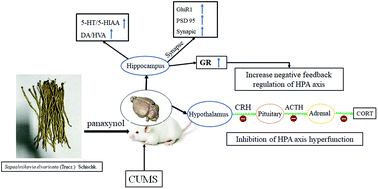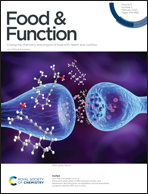Panaxynol attenuates CUMS-induced anxiety and depressive-like behaviors via regulating neurotransmitters, synapses and the HPA axis in mice
Abstract
Panaxynol (PAL, also called falcarinol) is widely found in plants of the Umbelliferae family, among which carrots are rich in PAL, so it is proved to be edible. PAL has neuroprotective effects and other pharmacological activities. This study aimed to explore the effects and mechanisms of action of PAL on chronic unpredictable mild stress (CUMS)-induced anxiety and depression in mice. The effects of PAL on behavioral activities in mice were first assessed by a CUMS-induced depression model. The secretion levels of monoamine neurotransmitters and hypothalamic-pituitary-adrenal (HPA) axis-related hormones were measured by ELISA. Western blotting was used to analyze the expression of glucocorticoid receptor (GR), glutamate receptor 1 (GluR1) and synapse-associated protein in the hippocampus. The behavioral experiment results showed that PAL can improve exploratory behavior and activities in mice. Meanwhile, PAL can significantly activate the release of 5-HT/5-HIAA and DA/HVA in the hippocampus. It inhibits the expression of adrenocorticotropic hormone (ACTH), corticosterone (CORT) and corticotrophin-releasing hormone (CRH) in serum and the hypothalamus. The contents of GR, glutamate receptor 1 (GluR1), postsynaptic density-95 (PSD95) and synapsin I protein in the hippocampus significantly increased. Studies have found that PAL can inhibit the hyperfunction of the HPA axis, which may be achieved by regulating HPA axis hormones and GR. Meanwhile, PAL promotes the release of 5-HT and DA in the hippocampus and improves synaptic plasticity in the hippocampus, allowing neurotransmitters to function more effectively. Therefore, PAL may improve anxiety and depression-like effects in mice through the abovementioned effects.



 Please wait while we load your content...
Please wait while we load your content...